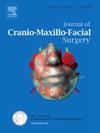Contralateral neck metastasis in lateralized cT3/4N0 oral squamous cell carcinoma
IF 2.1
2区 医学
Q2 DENTISTRY, ORAL SURGERY & MEDICINE
引用次数: 0
Abstract
Our goal was to investigate the pattern of contralateral lymphatic drainage (CLD) and contralateral neck failure (CNF) in cT3/4N0 oral cancer patients subjected to lymphoscintigraphy guided elective neck dissection (LSG-END) versus END. Patients were retrospectively enrolled and divided into two groups based on neck management. Pattern of CLD in LSG-END cohort was descriptively presented. Impact of LSG-END vs. END on CNF and overall survival was analyzed using Cox model. In total, 450 patients were included. In the LSG-END group, 54 patients exhibited CLD, resulting in an incidence of 23.5% and independently predicted by primary site, differentiation, tumor stage, and lymphovascular invasion. Contralateral levels I and II were the most involved site, and significantly influenced by primary site. In Cox model, patients treated with END had approximately double the risk of contralateral recurrence compared to those managed with LSG-END. Patients undergoing treatment with either END or LSG-END exhibited comparable OS rates. Among patients with cT3/4N0 oral cancer, CLD was observed in approximately one-quarter of the cohort. Although no additional overall survival advantage was identified, LSG-END proved to be more effective in controlling CNF compared to conventional END.
侧化cT3/4N0口腔鳞状细胞癌对侧颈部转移。
我们的目的是研究cT3/4N0口腔癌患者接受淋巴显像引导的选择性颈部清扫(LSG-END)和END的对侧淋巴引流(CLD)和对侧颈部衰竭(CNF)的模式。回顾性纳入患者,并根据颈部管理分为两组。描述了LSG-END队列CLD的模式。采用Cox模型分析LSG-END与END对CNF和总生存期的影响。总共纳入了450名患者。在LSG-END组中,54例患者出现CLD,发生率为23.5%,与原发部位、分化、肿瘤分期和淋巴血管浸润独立预测。对侧一级和二级是最受累的部位,受原发部位的影响显著。在Cox模型中,接受END治疗的患者与接受LSG-END治疗的患者相比,对侧复发的风险大约是前者的两倍。接受END或LSG-END治疗的患者表现出相当的OS率。在cT3/4N0口腔癌患者中,大约四分之一的队列中观察到CLD。虽然没有发现额外的总体生存优势,但与传统END相比,LSG-END被证明在控制CNF方面更有效。
本文章由计算机程序翻译,如有差异,请以英文原文为准。
求助全文
约1分钟内获得全文
求助全文
来源期刊
CiteScore
5.20
自引率
22.60%
发文量
117
审稿时长
70 days
期刊介绍:
The Journal of Cranio-Maxillofacial Surgery publishes articles covering all aspects of surgery of the head, face and jaw. Specific topics covered recently have included:
• Distraction osteogenesis
• Synthetic bone substitutes
• Fibroblast growth factors
• Fetal wound healing
• Skull base surgery
• Computer-assisted surgery
• Vascularized bone grafts

 求助内容:
求助内容: 应助结果提醒方式:
应助结果提醒方式:


